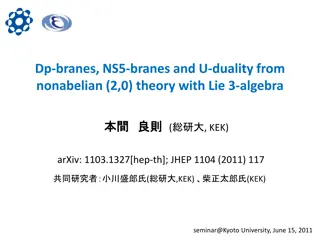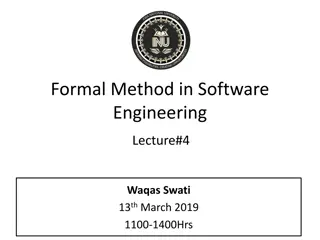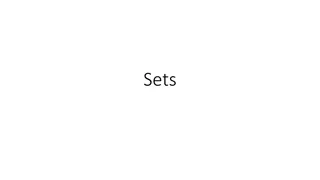Understanding Set Theory: A Brief Overview
Sets are essential in discrete mathematics and programming, serving as a fundamental concept for counting and operations. This chapter delves into the basics of set theory, defining sets as unordered collections of objects with elements or members. Different methods for describing sets, including the roster method, and examples of sets like vowels, integers, and more are explored.
Download Presentation

Please find below an Image/Link to download the presentation.
The content on the website is provided AS IS for your information and personal use only. It may not be sold, licensed, or shared on other websites without obtaining consent from the author. Download presentation by click this link. If you encounter any issues during the download, it is possible that the publisher has removed the file from their server.
E N D
Presentation Transcript
Set Theory Part I Chapter 3.1, 3.2, 3.3
Introduction Sets are one of the basic building blocks for the types of objects considered in discrete mathematics. Important for counting. Programming languages have set operations.
Introduction Sets are one of the basic building blocks for the types of objects considered in discrete mathematics. Important for counting. Programming languages have set operations. Set theory is an important branch of mathematics. Many different systems of axioms have been used to develop set theory. Here we are not concerned with a formal set of axioms for set theory. Instead, we will use what is called na ve set theory.
Sets A set is an unordered collection of objects. the students in this class the chairs in this room The objects in a set are called the elements, items or members of the set. A set is said to contain its elements.
Sets A set is an unordered collection of objects. the students in this class the chairs in this room The objects in a set are called the elements, items or members of the set. A set is said to contain its elements. The notation a A denotes that a is an element of the set A. If a is not a member of A, write a A
Describing a Set: Roster Method S = {a,b,c,d} Order not important S = {a,b,c,d} = {b,c,a,d}
Describing a Set: Roster Method Each distinct object is either a member or not; listing more than once does not change the set. S = {a,b,c,d} = {a,b,c,b,c,d}
Describing a Set: Roster Method Elipses ( ) may be used to describe a set without listing all of the members when the pattern is clear. S = {a,b,c,d, ,z }
Roster Method Set of all vowels in the English alphabet: V = {a,e,i,o,u} Set of all odd positive integers less than 10: O = {1,3,5,7,9} Set of all positive integers less than 100: S = {1,2,3, ..,99} Set of all integers less than 0: S = { ., -3,-2,-1}
Some Important Sets N N = natural numbers = {0,1,2,3 .} Z Z = integers = { ,-3,-2,-1,0,1,2,3, } Z Z = positive integers = {1,2,3, ..} = {x Z | x > 0} Q = set of rational numbers Q+= set of positive rational numbers Q*= set of rational numbers R R = set of real numbers
Interval Notation [a,b] = {x | a x b} [a,b) = {x | a x < b} (a,b] = {x | a < x b} (a,b) = {x | a < x < b} closed interval [a,b] open interval (a,b)
Special types of sets that come up often The empty set: ={} The natural numbers: N = {1, 2, 3, 4, .} The integers: Z = { ., -3, -2, -1, 0, 1, 2, 3, .} The rational numbers: Q = {1, , 1/3, , -1, -1/2, , 2, 2/3, , -2,-2/3, } The real numbers: R ={all real numbers on a number line}
Representation of a set A set can be expressed by listing its elements between commas, enclosed by braces. {2, 4, 6, 8} (finite set) { ., -4, -3, -2, -1, 0, 1, 2, 3, 4, ..} (infinite set) {{a,b, ...}, {0,1,2, ...., 9}, ... ,{ , , ....}, ....}
Representation of a set A set-builder notation is used to describe sets that are too complex to enumerate them. Suppose E={ ., -6, -4, -2, 0, 2, 4, 6, .} Set-builder notation E={n : n is an even integer} or E={n | n is an even integer} Other examples A = {x : x is an integer |x| < 4} = {-3, -2, -1, 0, 1, 2, 3} The rational numbers: Q={x : x = m/n, m,n Z, n 0}
Some illustrations of set-builder notation
Conceptually: Conceptually, a set is like a bag containing objects. This bag can contain another bag containing other objects. Example: A= {1, {1}, {2}, {1,2}} How many elements are in A? 1 A? 2 A? {2} A? {{2}} A?
Equality of Sets, Subsets If B is a subset of A, every element of B is an element of A. We write B A. Two sets are equal if they have the same elements. To show that two sets are equal, it is sufficient to show separately that A B and B A
Equality of Sets, Subsets (contd.) Z+ is N, the set of natural numbers Q+ is the set of all positive rational numbers
Subsets (contd.) A set B is a proper subset of a set A, if it is a subset A and is not equal to A ( ). If A is a subset of B and B is a subset of C, A is a subset of C. (Transitive relation) Note that if A has at least one element, is a proper subset of A.
Cardinality of a set Cardinality of a set A, denoted by |A|: It is the number of elements in the set A set with finite number of elements is called a finite set. A set with infinite number of elements is called an infinite set. Sets N, Z, Q, R are all infinite. Empty set has no element, denoted by How many elements does the set { } contain?
Power set Given a set A, the power set of A, P(A), is the set of all subsets of A. Examples Let A={a,b,c}, P(A)={ ,{a},{b},{c},{a,b},{b,c},{a,c},{a,b,c}} Let A={{a,b},c}, P(A)={ ,{{a,b}},{c},{{a,b},c}} Note: the empty set and the set itself are always elements of the power set.
Power set The power set is a fundamental combinatorial object useful when considering all possible combinations of elements of a set Fact: Let S be a set such that |S|=n, then |P(S)| = 2n Some intuition?
Power set For B={1,2,3,4}
Ordered collection of objects Sometimes we need to consider ordered collection of objects. Consider a set S of points in the plane.
Ordered collection of objects Sometimes we need to consider ordered collection of objects. Consider a set S of points in the plane. pi =(xi,yi) is the x-y coordinate of the ith point. S={(x1,y1), (x2,y2), , (xm,ym)} represents a set of m ordered objects. Each object is an ordered collection of two elements. S = {p1,p2, , pm} is also fine.
Tuples Definition: The ordered n-tuple (a1,a2, ,an) is the ordered collection with the element ai being the ith element for i=1,2, ,n. Two ordered n-tuples (a1,a2, ,an) and (b1,b2, ,bn) are equal iff for every i=1,2, ,n we have ai=bi. A 2-tuple (n=2) is called an ordered pair.
Section Summary Set Operations Union Intersection Complementation Difference
Union Definition: Let A and B be sets. The union of the sets A and B, denoted by A B, is the set: Example: What is {1,2,3} {3, 4, 5}? Venn Diagram for A B Solution: ? U A B
Union Definition: Let A and B be sets. The union of the sets A and B, denoted by A B, is the set: Example: What is {1,2,3} {3, 4, 5}? Venn Diagram for A B Solution: {1,2,4,5} U A B
Operations on Sets Let A and B be two arbitrary sets. Let U be the universal set, (i.e. A U and B U). Union: A B = {x: x A or x B} Intersection: A B = {x: x A and x B} Difference: A B = { x: x A and x B} Symmetric Difference: A B = {x: (x A and x B) or (x A and x B)} = (A B) (B A) Complement: U A = {x : x A}
Review Question Example: U = {0,1,2,3,4,5,6,7,8,9,10} A = {1,2,3,4,5}, B ={4,5,6,7,8} 1. A B Solution: 2. A B Solution: 3. Solution: 4. Solution: 5. A B Solution: 6. B A Solution:
Review Question Example: U = {0,1,2,3,4,5,6,7,8,9,10} A = {1,2,3,4,5}, B ={4,5,6,7,8} 1. A B Solution:{1,2,3,4,5,6,7,8} 2. A B Solution:{4,5} 3. Solution:{0,6,7,8,9,10} 4. Solution: {0,1,2,3,9,10} 5. A B Solution:{1,2,3} 6. B A Solution:{6,7,8}
Operations on Sets A={(x,x2) : x R} B={(x,ax + b) : x R and a,b R}
Venn Diagram It is often used to visualize the various relations between the sets.
Intersection The intersection of sets A and B, denoted by A B, is the set that contains those elements in both A and B. U A B
Union The union of sets A and B, denoted by A B, is the set that contains those elements that are in either A or B. U A B
Set Difference Definition: The difference of two sets A and B, denoted A B, is the set containing those elements that are in A but not in B U A B
Set Complement Definition: The complement of a set A, denoted A, consists of all elements not in A. That is the difference of the universal set U and A. A = {x | x A } U A A
Disjoint Sets Definition: Two sets are said to be disjoint if their intersection is the empty set: A B = U A B
Set identities Set identities are basic laws on how set operations work Many have already been introduced on previous slides Just like logical equivalences! Replace U with Replace with Replace with F Replace U with T
Set identities: DeMorgan again These should look very familiar = A B A B = A B A B
Proof by using basic set identities Prove that A B=B-(B-A) = A B B-(B A ) Definition of difference Definition of difference = = = B (B A ) DeMorgan s law B B B B ( ( A A) ) Complementation law = = = = Distributive law (B (B A B (B A) B ) (B A) A) Complement law Identity law Commutative law
What is a membership table ? Membership tables show all the combinations of sets an element can belong to 1 means the element belongs, 0 means it does not Consider the following membership table: A 1 1 0 0 B 1 0 1 0 A U B A B 1 1 1 0 A - B 0 1 0 0 1 0 0 0 The top row is all elements that belong to both sets A and B Thus, these elements are in the union and intersection, but not the difference
What is a membership table ? Membership tables show all the combinations of sets an element can belong to 1 means the element belongs, 0 means it does not Consider the following membership table: A 1 1 0 0 B 1 0 1 0 A U B A B 1 1 1 0 A - B 0 1 0 0 1 0 0 0 The second row is all elements that belong to set A but not set B Thus, these elements are in the union and difference, but not the intersection
What is a membership table ? Membership tables show all the combinations of sets an element can belong to 1 means the element belongs, 0 means it does not Consider the following membership table: A 1 1 0 0 B 1 0 1 0 A U B A B 1 1 1 0 A - B 0 1 0 0 1 0 0 0 The third row is all elements that belong to set B but not set A Thus, these elements are in the union, but not the intersection or difference























